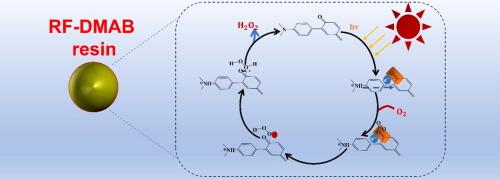当前位置:
X-MOL 学术
›
Sep. Purif. Technol.
›
论文详情
Our official English website, www.x-mol.net, welcomes your
feedback! (Note: you will need to create a separate account there.)
Boosting photocatalytic H2O2 production by incorporating extra electron-donor group over resorcinol-formaldehyde resin
Separation and Purification Technology ( IF 8.1 ) Pub Date : 2024-11-16 , DOI: 10.1016/j.seppur.2024.130565 Shenyan Xu, Hongxiang Chu, Xin Qin, Bei Jiang, Ruofan Li, Taikang Jia, Wenjing Wang, Chunyu Che, Yongsheng Wu, Ling Zhang, Chuanqi Zhang, Wenzhong Wang
Separation and Purification Technology ( IF 8.1 ) Pub Date : 2024-11-16 , DOI: 10.1016/j.seppur.2024.130565 Shenyan Xu, Hongxiang Chu, Xin Qin, Bei Jiang, Ruofan Li, Taikang Jia, Wenjing Wang, Chunyu Che, Yongsheng Wu, Ling Zhang, Chuanqi Zhang, Wenzhong Wang

|
The photocatalytic production of hydrogen peroxide from water and oxygen using solar energy presents a promising approach. Nevertheless, challenges persist regarding the efficiency of this process and the clarification of the underlying catalytic mechanisms. In this study, we synthesized a donor-acceptor type photocatalyst, modified resorcinol-formaldehyde resin. FT-IR and XPS analyses confirmed the successful incorporation of an additional electron donor unit, N, N-dimethylaniline, which interacts with the electron acceptor unit to facilitate the directed migration of photogenerated electrons. Furthermore, this modification creates an electron-rich carbonyl active center, enhancing its capacity to adsorb and reduce O2, thereby improving the photocatalytic production of H2O2. In situ EPR and DRIFT analyses identified key intermediates, substantiating a two-step, single-electron oxygen reduction pathway and providing insights into the catalytic mechanism. Importantly, without the use of sacrificial agents or additional aeration, the photocatalytic production rate of H2O2 reached 22.8 μmol·h−1, underscoring its potential as an effective photocatalyst. This study elucidates the reaction mechanism during the photocatalytic process, offering valuable insights for future material design aimed at enhancing hydrogen peroxide production rates.
中文翻译:

通过在间苯二酚-甲醛树脂上掺入额外的电子供体基团来促进光催化 H2O2 的产生
利用太阳能从水和氧气中光催化生产过氧化氢是一种很有前途的方法。然而,在这个过程的效率和潜在催化机制的澄清方面仍然存在挑战。在这项研究中,我们合成了一种供体-受体型光催化剂,改性间苯二酚-甲醛树脂。FT-IR 和 XPS 分析证实了成功掺入一个额外的电子供体单元 N,N-二甲基苯胺,它与电子受体单元相互作用以促进光生电子的定向迁移。此外,这种修饰产生了一个富含电子的羰基活性中心,增强了其吸附和还原 O2 的能力,从而提高了 H2O2 的光催化生产。原位EPR 和 DRIFT 分析确定了关键中间体,证实了两步单电子氧还原途径,并提供了对催化机制的见解。重要的是,在不使用牺牲剂或额外曝气的情况下,H2O2 的光催化产生速率达到 22.8 μmol·h-1,强调了其作为有效光催化剂的潜力。本研究阐明了光催化过程中的反应机理,为未来旨在提高过氧化氢生产率的材料设计提供了有价值的见解。
更新日期:2024-11-16
中文翻译:

通过在间苯二酚-甲醛树脂上掺入额外的电子供体基团来促进光催化 H2O2 的产生
利用太阳能从水和氧气中光催化生产过氧化氢是一种很有前途的方法。然而,在这个过程的效率和潜在催化机制的澄清方面仍然存在挑战。在这项研究中,我们合成了一种供体-受体型光催化剂,改性间苯二酚-甲醛树脂。FT-IR 和 XPS 分析证实了成功掺入一个额外的电子供体单元 N,N-二甲基苯胺,它与电子受体单元相互作用以促进光生电子的定向迁移。此外,这种修饰产生了一个富含电子的羰基活性中心,增强了其吸附和还原 O2 的能力,从而提高了 H2O2 的光催化生产。原位EPR 和 DRIFT 分析确定了关键中间体,证实了两步单电子氧还原途径,并提供了对催化机制的见解。重要的是,在不使用牺牲剂或额外曝气的情况下,H2O2 的光催化产生速率达到 22.8 μmol·h-1,强调了其作为有效光催化剂的潜力。本研究阐明了光催化过程中的反应机理,为未来旨在提高过氧化氢生产率的材料设计提供了有价值的见解。


















































 京公网安备 11010802027423号
京公网安备 11010802027423号